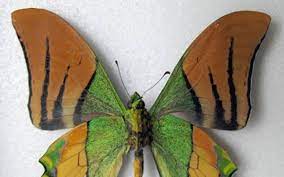16 Nov 2021 Kaiser-e-Hind

- Recently Arunachal Pradesh has approved the big and bright colored butterfly ‘Kaiser-e-Hind’ as the state butterfly.
- ‘Kaiser-e-Hind’ literally means ‘Emperor of India’.
Scientific name: Tinopalpusimperialis
Habitat:
- It is one of the rare and swallowtail butterflies found in medium and high altitudes.
- Swallowtails are a group of butterflies in the butterfly family Papilionidae (Order Lepidoptera).
- It is found in broad-leaf temperate evergreen forests at higher altitudes.
- Temperate evergreen forests are found in the eastern and western Himalayas.
- This butterfly with a wingspan of 90-120 mm is also found along the eastern Himalayas (West Bengal, Meghalaya, Assam, Sikkim and Manipur).
- Its presence indicates the existence of a better forest ecosystem and conservation.
- This butterfly is also found in Nepal, Bhutan, Myanmar, Laos, Vietnam and southern China.
Protection Status:
- IUCN: Near Threatened
- CITES: APPENDIX-II
- Wildlife (Protection) Act, 1972: Schedule-II
Butterfly:
Introduction:
- Butterflies are insects belonging to the order Lepidoptera of the Arthropoda phylum, which also includes moths.
- Adult butterflies have large and often brightly colored wings.
- Recently a Himalayan butterfly popularly known as ‘Golden Birdwing’ (Troidesacus) has been discovered as India’s largest butterfly after 88 years.
Importance:
- Rich Biodiversity: The abundance of butterflies in any region represents rich biodiversity.
- Indicator Species: Butterfly acts as an indicator species.
- An indicator species provides information on the overall status of an ecosystem and other species in that ecosystem. It also reflects the quality and changes in environmental conditions as well as aspects of community structure.
- Pollinator: It acts as a pollinator by helping in pollination and in the protection of many species of plants


No Comments